
The decision to transition from gas to battery-powered equipment is a significant choice. This change provides various benefits but also requires a concerted effort to be implemented effectively. For businesses like BrightView, based in Blue Bell, Pennsylvania, and Serpico, based in Hayward, California, their decision to transition to battery power is driven by who they are as companies.
“At BrightView, we’re committed to embracing environmentally responsible practices and making progress toward carbon neutrality,” says Holger Arnold, BrightView’s vice president of operational excellence. “The transition to electric is just a piece of our pledge to help ensure a greener future for everyone.”
BrightView isn’t just stopping at battery-powered equipment; they are also converting their management fleet of 3,000 cars and trucks to more sustainable power sources. Arnold says they have purchased approximately 400 electric and hybrid vehicles in the fiscal year of 2022 to begin this conversion.
Peter Novak, president and CEO of Serpico, says resource conservation is one of their core values and those values drive every decision the company makes. Novak says they tested battery-powered equipment for six years to find a brand that meets their needs. One of the questions they faced was whether they wanted to commit to just one manufacturer.
“A lot of contractors, Serpico included, would say part of our strategy is never putting all of our eggs in one basket,” Novak says. “I know a lot of contractors who live that every day because that strategy spreads risk out for them. If a key supplier goes down, their business can still function. That was a macro-level concern for us. Would there be a manufacturer that we could put our faith in to be there for us?”
Serpico ended up finding a brand that they could count on and has converted 20 percent of their routes to hybrid/electric fleets so far. Both companies say it is a point of pride for their employees to be part of this transition.
“It definitely brings a new energy to the company,” Novak says. “We’ve got our folks super excited to use the equipment, and they feel special. We care deeply about what we do and believe we’re stewards of the earth. That’s how we feel about it, and we feel like it’s the right thing for us to do to take good care of it.”
Run Time and Charge Time
One of the most common questions regarding battery-powered equipment is “How long does it run?” and manufacturers might answer, “It depends.”
However, this isn’t them being evasive. It truly comes down to usage, which determines the appropriate battery and tool. For instance, Greenworks Commercial offers 2.5AH, 4AH, 5AH, 8AH, and 12AH batteries, allowing the landscaper to choose the right battery for the right tool to match their job requirements.
“We’ve seen tons of companies get kitted out with the incorrect batteries – maybe not knowing, for example, that a larger battery was available – so they weren’t getting the same run time prompting the thought of ‘Oh well, this isn’t meeting my needs,’” says Jack Easterly, global business segment manager with Husqvarna. “A lot of this could be solved with better communication.”
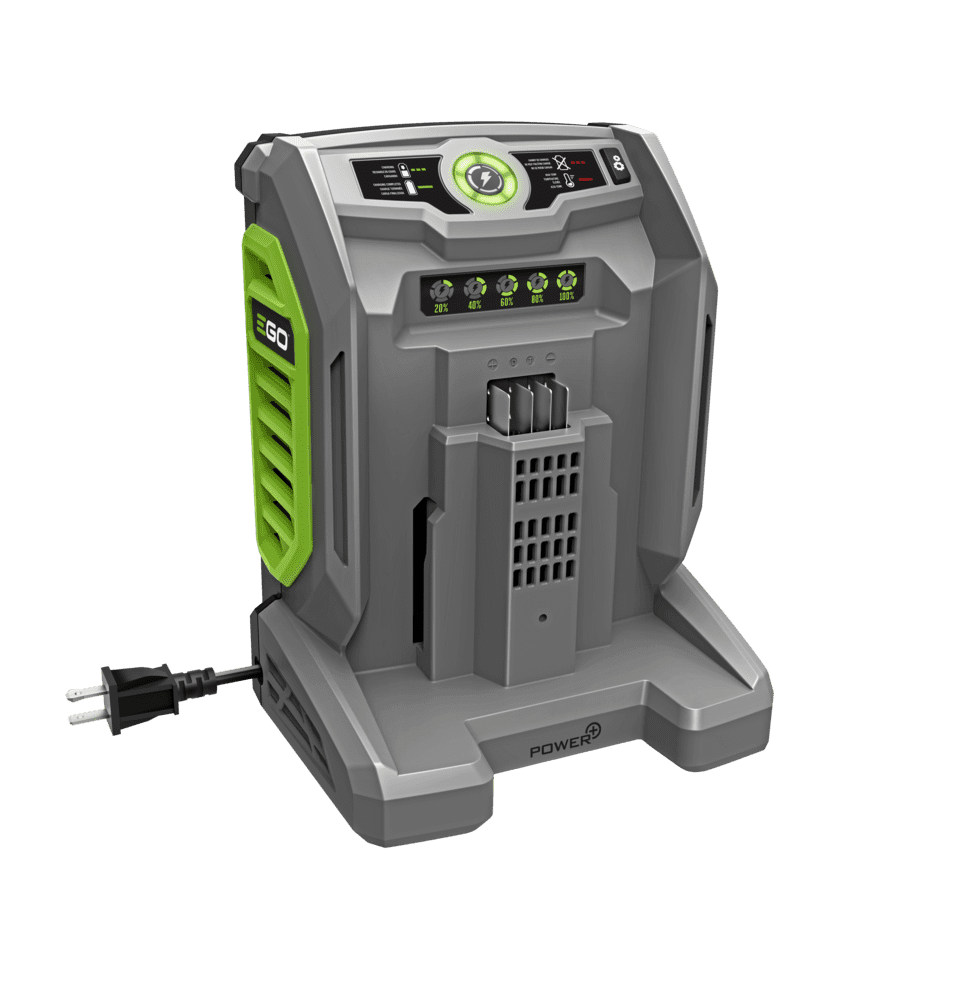
Tim Baker, director of product management for EGO, says part of this research is understanding the “on time” numbers for your existing equipment.
“Evaluating on time per crew and per product will be really important in calculating battery and charging requirements as well as possible upgrades to your electrical infrastructure,” Baker says. “Make sure to evaluate on time during ‘normal’ operations and at peak times throughout the calendar year.”
Paul Beblowski, a STIHL professional battery product manager, encourages talking to your local dealer to select the right tool and batteries for the job. He says STIHL is also working to develop educational resources that will be rolled out throughout 2023 to help with the cost/benefit analysis.
Novak says through trial and error, they have been able to fine-tune the necessary amount of battery packs to send out with their crews.
“Every route is different,” Novak says. “One route may be blower heavy. Another route may need more hedge trimmers or mowers. The way that we did it in the early days was to send a crew out with an estimated number of battery packs, and we literally told them, ‘You may or may not be able to finish your day. Use good technique and do the best that you can, but we need the feedback because that’s gold to us.’”
He says they started purchasing hybrid trucks with built-in 7.2-kilowatt generators so they could take advantage of on-road charging and use fewer battery packs per route. Meanwhile, BrightView is piloting the use of electric charging trailers. Novak says technology is always improving as far as battery charge times and battery power.
For instance, Greenworks Commercial has a rapid six-pack charger that allows landscapers to charge six batteries at a time and their new Optimus Mobile Charging trailer allows landscapers to always have charged batteries, whatever the job scope or size.
“The STIHL charging cabinet houses three AL 301-4 multi-chargers that can recharge 12 fully depleted AP 300 S cartridge-style batteries in a little over 4.5 hours,” Beblowski says. “This product is designed to attach to a truck or trailer or can be stored in a workshop.”
Baker says EGO is launching a DC-DC fast charger this year that uses a larger format battery to turbo charge two EGO 56v Arc Lithium batteries simultaneously, allowing landscape professionals to carry fewer batteries to get through the day.
STIHL also has introduced the AP 500 S batteries that use power-laminate cell technology, which is 40 percent more powerful than the AP 300 S batteries.
“When properly cared for, the AP 500 S can accept up to twice as many charging cycles as compared to conventional lithium-ion batteries, providing a significant increase in service life,” Beblowski says. “And with the STIHL Battery Management System (BMS), landscapers get maximum tool performance through optimized battery power management.”
Novak says having fast charge times also helps mitigate issues like the rolling blackouts that California has experienced.
“Our battery packs charge very fast,” Novak says. “When everybody gets back at the end of the day, plugs everything in, the batteries are all charged within the next two hours. The big mowers they’re fully charged within four hours using available fast chargers. As long as we’re really good with plugging stuff in immediately when we do have power, 99.9 percent of the time it’s fully charged when we need it, and if the power does drop off that night, it’s a full battery, so when they roll out in the morning, it’s good.”
But What About the Blowers?
The one tool often cited by contractors as ‘not quite there yet’ is the backpack blower. Easterly says this is because it comes down to creating a product that has the desired power and run time without being too heavy.
“You have to find the right balance of those three attributes in order to get a piece of equipment that has enough power to do the job, lasts long enough, so you aren’t changing out batteries all the time, and isn’t going to be so heavy (due to the battery) that it will fatigue the operator,” Easterly says.
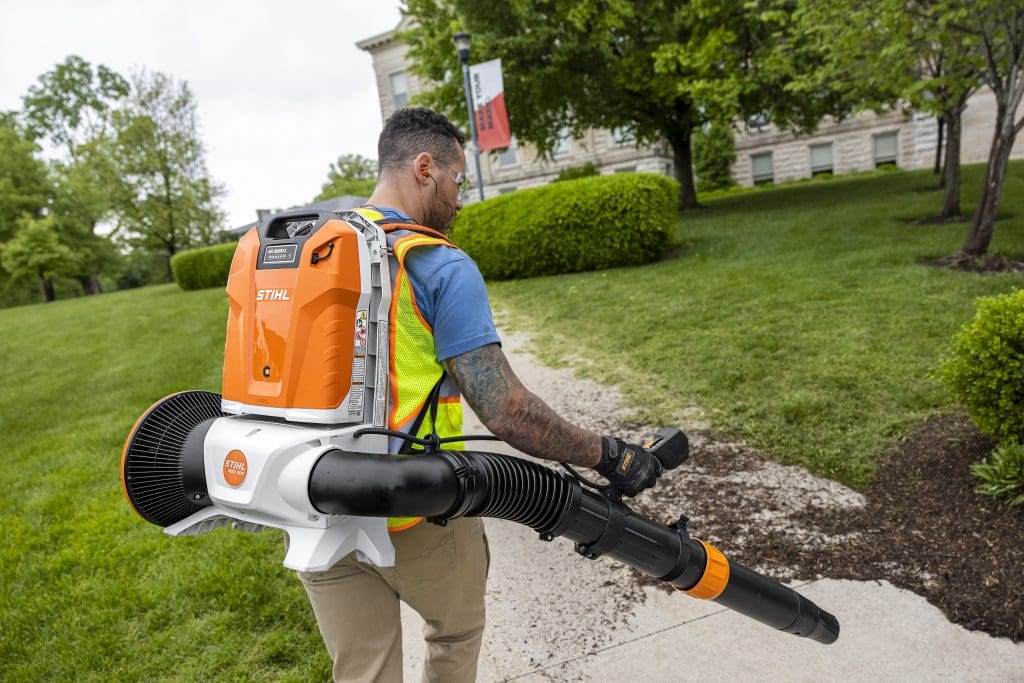
Some manufacturers say their blowers are already there. Tony Marchese, senior vice president for Greenworks Commercial, says their new 8AH batteries combined with their GBB700 backpack blower allow landscapers to have the productivity and run time they experience with their gas backpack blowers.
“The new BGA 300, the first STIHL battery-powered backpack blower, is an example of how far battery power has come,” Beblowski says. “Equivalent to the BR 430 in blowing force, we believe this product will be an asset to pros within regulated work zones and those looking for a more environmentally friendly option. The STIHL BGA 300 delivers a powerful 26-newtons of blowing force and a max air speed of 192 MPH for heavy-duty clearing of both dry and wet debris, giving pros even more gasoline-comparable options to add to their fleet.”
Baker agrees for mow and blow operations that focus on single-family homes, the technology is already there for blowers. Their new dual port commercial backpack blower will be able to meet the needs of crews maintaining larger properties as it can run on high for over an hour with two 12 amp-hour batteries.
Novak points out that in most cases, the viability of battery-powered backpack blowers depends on the task, but landscapers also need to adjust their technique rather than running a piece of equipment full throttle nonstop.
“Part of the game is retraining your teams to understand that there is a technique that has to change with this equipment,” Novak says. “If you adopt those techniques, you will be able to do all your work and then some. It’s not inhibiting you from doing your work; it’s just a change in technique.”
Cost and Communication
The matter of funding has to be addressed when considering switching to battery power. There is a higher upfront cost to handheld battery products and Novak looks at purchasing battery packs as buying his fuel in advance. Higher electric bills can be expected, but this increase is nominal compared to the expenses of gas, two-stroke oil mix, maintenance and repairs. Novak suggests looking into local government programs that can help offset some of the investment costs.
“Assuming electric tools, batteries, and chargers last long enough to pay for themselves, professionals can be rewarded with reduced operating and maintenance costs usually at year three for handheld tools and four to five years for large battery-electric mowers,” says Dan Mabe, CEO and president of American Green Zone Alliance (AGZA). “Any tax incentive or retail price reduction programs of course help accelerate the ROI (return on investment).”
Marchese says a Greenworks Commercial Optimus zero-turn allows the landscaper to see $18,932 in actual savings versus a gas zero-turn.
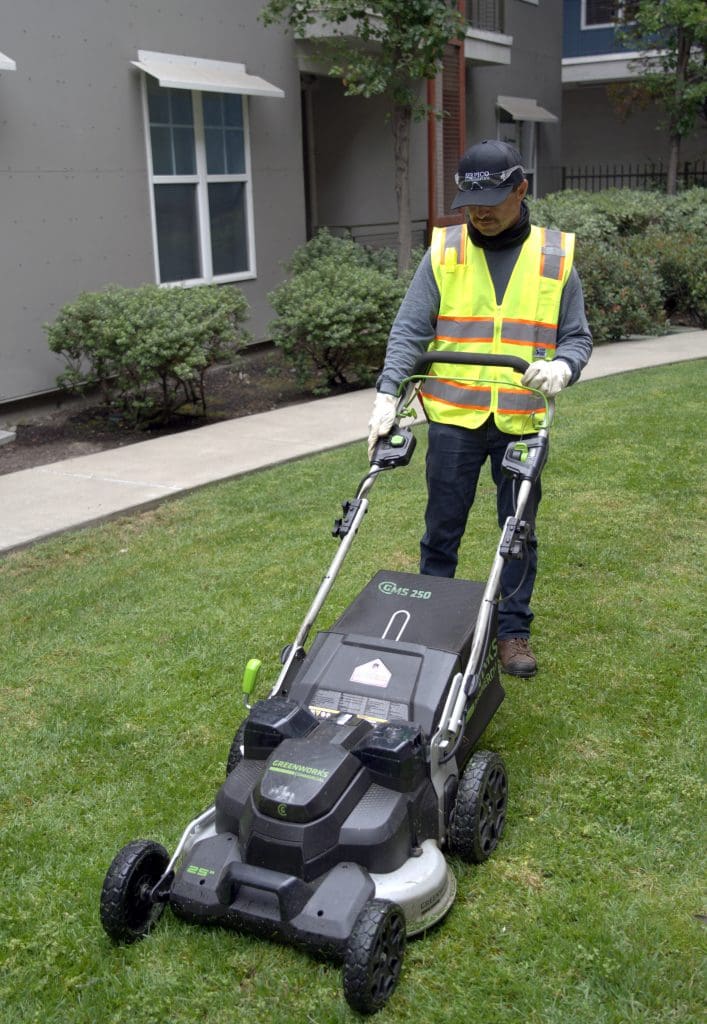
The actual implementation is the next major phase of the transition. Operationally, you have to get your team on board with this change.
“In our industry, as many contractors will know, the guys are super connected to the machines they use and so when you take away their Honda 21” mower and you give them something else they look at you like you’re a crazy person,” Novak says. “You check back a week later and they’ve got that 21” back out on their route again because they just can’t let it go.”
Marchese says you need to develop a communication strategy with your team, so they know how to “carry their fuel” and have the correct number of charged batteries to complete the workday.
Novak says you must win the hearts and minds of your workforce with the new equipment. In Serpico’s case, it took time to adjust, but they were strategic with how they presented the change to their team. Novak says they were clear they wanted the staff’s feedback and engaged them in the decision-making process.
Part of the transition also means changing how you utilize your equipment and train your crews. Mabe encourages conducting workforce education to ensure competence and safety.
“Workforce attitudes and adoption of electric technologies and operations will give companies a better chance for positive outcomes and long-term success,” Mabe says. “Return on investment for fleets of battery electric equipment is contingent on how workers treat and take care of the tools, batteries, and chargers.”
Essential Infrastructure Considerations
Rolling out an all-electric fleet calls for a serious infrastructure change. This includes considering everything from your trucks and trailers to your facility’s charging capabilities.
“We highly recommend running an enclosed trailer setup when you’re switching to battery for two reasons, theft and then weather protection,” Easterly says. “It also ties into the charging solution. Lots of companies are permanently mounting chargers in the trailer.”

Baker adds that depending on your location, you may want to add passive cooling solutions to your trailer to keep the temperatures of the batteries at a reasonable level and to dissipate heat that may be generated during on-the-go charging.
The size and nature of your business will determine how much of an investment you’ll have to make when it comes to implementing the necessary infrastructure for safe charging.
“Larger companies who have yards with adequately ventilated and weatherproofed storage structures and existing electricity from the utility company will have an advantage over the small independent gardeners who may have to take their batteries into their homes and apartments to charge and prevent theft every single night after a long day’s work,” Mabe says. “Generally, everyone should consider using circuits that are connected to at least 20 amp breakers on their panel. Do not share the circuits used for charging with microwaves, HVACs, refrigerators, or other chargers and appliances drawing high amperages.”
Mabe advises using a power distribution manager, rather than power strips if you need to charge more than five batteries each night. For large mowers with chargers drawing 50 amps or more, upgrading and installing 240 circuits should be considered.
“This is absolutely something that requires a professional to install and take care of and understand what’s needed,” Easterly says. “Again, it’s going to take the team effort of us and them understanding the batteries, how much does need to be charged overnight and therefore what needs to be added to their building to be able to charge that much stuff.”
For Serpico, they are currently retrofitting their existing facility. Novak says this has been a learning experience for them. He suggests consulting your local energy provider to see how many amps you can draw from the grid. In some cases, you might have more than enough for your crews, and in other cases, you could be seriously underpowered.
“I’ve come to the conclusion that for companies who are going down this path like us there are really two ways that it can happen,” Novak says. “Number one, you retrofit your existing facility and you put a huge investment in improving that facility to have a lot of juice running through it, or you go out you build a facility from the ground up that’s set up to do these things.”
Meanwhile, EGO is launching a new set of power solutions this year designed to reduce the need to upgrade electrical infrastructure to support cordless charging.
“The system is designed to charge about 200 amp hours of EGO 56v batteries overnight on a single 15 amp, 110v electrical circuit,” Baker says. “You can mix and match any capacity of EGO batteries in this charging system using our Power Hub and 3-port charging adapter.”
Novak says aside from having the charging infrastructure installed, landscapers also need to implement redundancies to ensure their batteries are able to charge in the case of unforeseen events like a storm causing a power outage.
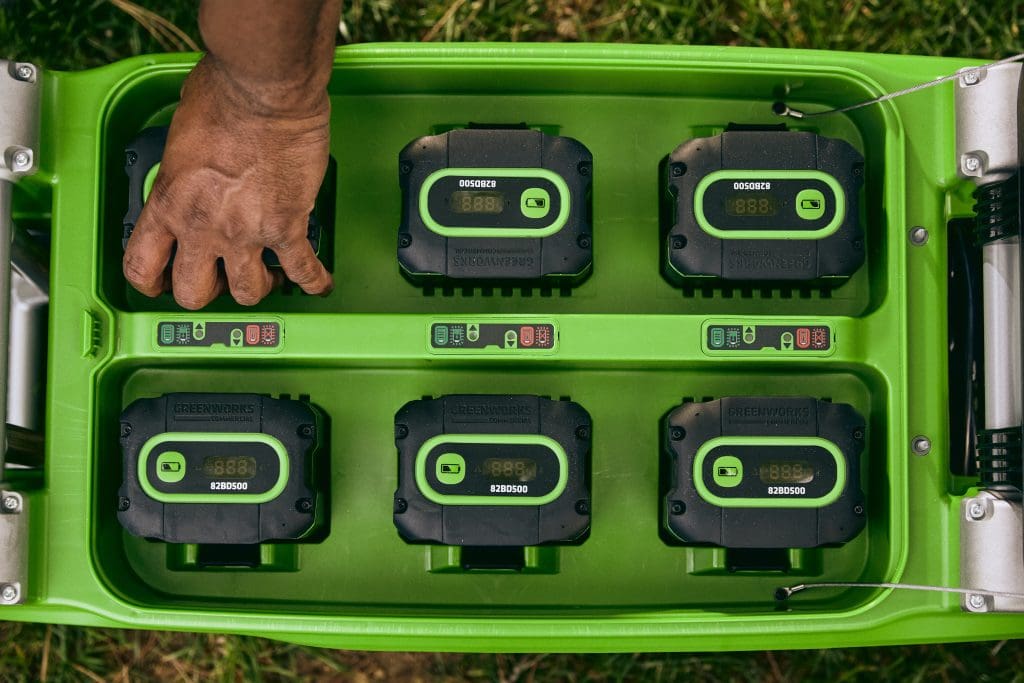
“Every branch has an alternative power generation redundancy,” Novak says. “We’ve got generators set up to kick in when they may be needed if we have a serious blackout.”
He says even if they did have to launch with only 50 percent of battery packs charged in the morning, they can take advantage of their on-road charging, which combined with the quick recharge times, afford them the power they need to execute the day’s work. They would not revert to gas equipment in these instances.
“Whenever we convert a route, we don’t go backwards,” Novak says. “We make sure we get to that point where we have all the pieces in place. We can achieve our production and we know how much we need.”
Recycling Batteries
Recycling isn’t always top of mind when evaluating the transition to battery power, but it shouldn’t be ignored. Novak says it’s one of the few drawbacks to the shift, as they had a hard time finding a partner who could accept these robust battery packs.
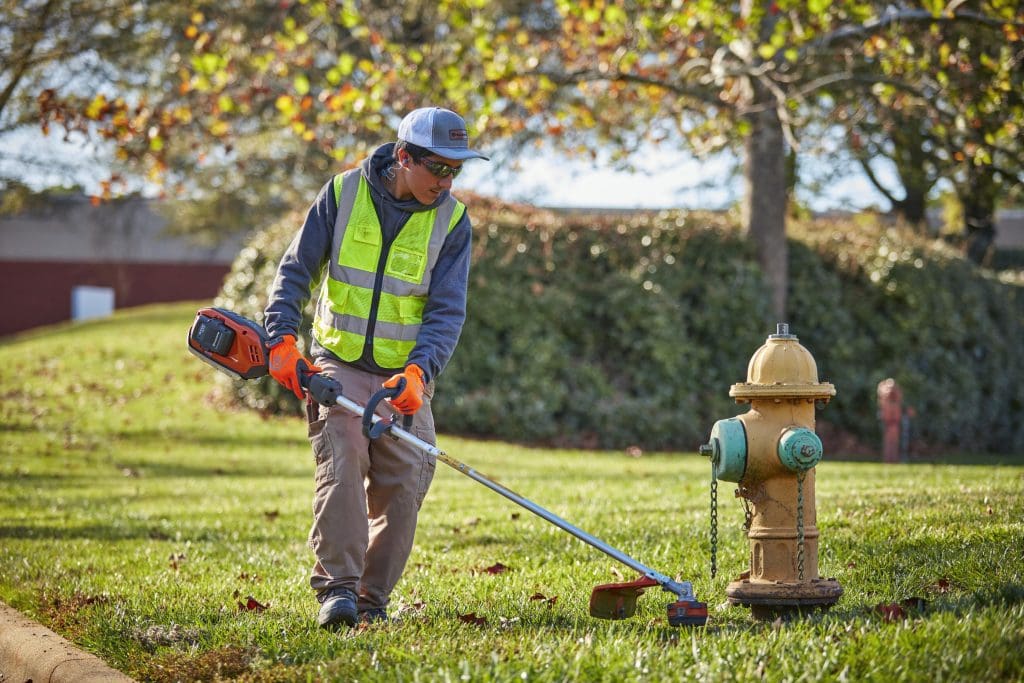
“These battery packs last a long time, so that’s been a benefit to us,” Novak says. “We’ve only recycled four battery packs since we started this journey.”
Mabe encourages choosing to buy battery equipment from responsible manufacturers.
“We all need to be responsible end users and return defective and spent batteries that are no longer useful to power a piece of equipment under load anymore to the dealer where it was purchased,” Mabe says. “We all can ask the dealer prior to purchase if they are going to take batteries back and have the manufacturers retrieve them for either repurposing or recycling. Make sure you receive clear and definitive answers when inquiring about recycling and where to take batteries.”
Brands like STIHL and Husqvarna work with Call2Recycle where landscape professionals can drop off batteries at the end of their service life. EGO partners with Rechargeable Battery Recycling Corporation (RBRC).
“RBRC makes it easy to recycle batteries by locating drop boxes at places where professional landscapers are likely to shop,” Baker says. “We are always evaluating alternative ways to recycle or even reuse batteries. For instance, we’re investigating ways to reuse batteries that may have dropped below 70 percent of their original charge capacity, but can still be used in applications where their remaining charge capacity is satisfactory. A lot of the cost (and waste) that goes into Li-Ion batteries is the labor and materials to assemble finished battery packs, not the raw materials. Getting the most possible life out of assembled and intact batteries is the best way to minimize waste.”
EGO is also working to create different battery designs and chemistries that can extend the lifespan of batteries.
“We are also working on charging solutions that will give professional landscapers the flexibility to choose whether they want to optimize their current batteries for run time or cycle life,” Baker says.
The Future of Gas
One major question is the role of gas in the industry moving forward. STIHL is choosing to make more environmentally responsible gas and battery-powered products and provide landscapers the options they need to complete the tasks at hand.
“While battery is undoubtedly the industry’s future, STIHL continues to introduce new and powerful gasoline-powered options to the market,” Beblowski says. “STIHL believes in providing the landscaper with the performance they need from whatever power source they desire.”
Easterly notes that while battery continues to gain momentum and interest, the future is hard to predict. Husqvarna is committed to innovating for the future while acknowledging that there may be a need and role for gas tools. Mabe adds that electric equipment could be more vulnerable to supply chain issues and believes that a combination of internal combustion and battery electric equipment is needed for the foreseeable future.
“When you factor in what is needed to mine lithium and other precious materials, retrofit, upgrade, and modernize electrical grids and buildings to accommodate the necessity to charge millions of batteries ranging from 250-watt hours to 100 or more kilowatt hours, AGZA believes there are limitations for electric to become the only technology for the landscape maintenance industry,” Mabe says. “We all have to consider the much higher upfront cost of battery tools, and the fluctuation of an adequate supply of materials, components, and the batteries themselves. The industry is competing with the EV and solar industries for similar resources. The focus should be on what electric tools will produce an advantageous economic and work productivity outcome.”

BrightView believes the transition to electric will be easier as the infrastructure develops to support the electric supply chain and future.
“We are determined to achieve a sustainable future with carbon neutrality where everyone for centuries to come can enjoy and benefit,” Arnold says. “Our commitment to this vision can be directly seen through the expansion of our electric fleet and carbon-neutral landscaping equipment.”
Baker says he expects the value proposition of cordless to continue to improve over the coming years and for there to be a full spectrum of battery-powered tools, from logging chainsaws to riding mowers with a variety of deck sizes eventually.
Novak says he doesn’t see landscape fleets becoming completely electric with electric trucks, but rather hybrid electric vehicles as the next long-lasting step.
“You have the redundancy built in,” Novak says. “We have to be prepared for as many variables as we can because we deal with the weather. We deal with environmental things happening in the blink of an eye that may or may not impact how we’re able to produce our tasks.”
Marchese says they are working with the largest landscapers in the U.S. and they can see the overall benefits of transitioning to battery which include being quieter, having less maintenance and zero emissions.
“Ultimately, I think it just comes down to the core of what we are, and I think the industry needs to have a conversation with itself about that,” Novak says. “What are the universal values of this industry? If we believe that we’re in an industry that are caretakers of living things, both in the way that we sculpt the environment and the way that we provide that environment for other human beings to enjoy their lives, if we’re true to that belief, then I don’t know that there is an alternative. Part of providing that total living environment is doing things that help it continue living.”
This article was published in the March/April issue of the magazine. To read more stories from The Edge magazine, click here to subscribe to the digital edition.

